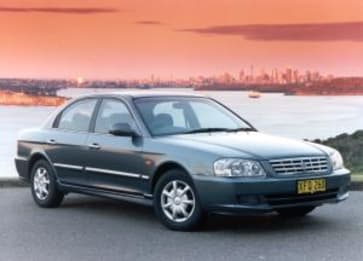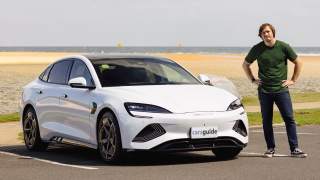
Kia Optima 2001 Review

There has been a major turnaround by Korean carmakers in the past few years. Hyundai, after a decade of producing cut-price cars, has led a challenge to Japanese rivals with a new generation of cute-looking, well-built machines.
At Kia, the flow-on effect of Hyundai recently buying a stake is even more noticeable in its new flagship Optima sedan. The Optima is the first shareware car between the two, getting its basic hardware from the Hyundai Sonata. It is also Kia's first credible attempt at building a large family sedan. The Optima replaces the ugly and outdated Credos sedan, which was based on the Mazda 626 of the early '90s.
Body and appearance
The Optima and the Sonata share the same body architecture, but they have completely separate identities through different front and rear-end styling. The Optima is also the final piece in Kia's product-led revolution in Australia through its new local distributor, Ateco Automotive.
It follows the trendy Rio small car, the Carens mini people-mover and updated Spectra, Sportage and Carnival models over the past year.
Most importantly, the Optima is taking Kia right into the heart of Toyota country as it lines up against the top-selling Camry in price and specifications.
Price and equipment
Like all new Kia models, the Optima comes to Australia in just one trim level, with the manual-gearbox model costing $24,990 and the self-shifting auto selling for $27,490. There is just one other option: metallic paint, adding $170.
There is a long list of standard features, including air-conditioning, a driver's airbag, power steering, remote central locking, full electrics and CD sound.
Drivetrain
The car is powered by a 2.5-litre V6, which produces 127Kw of power at 6000 revs and 230Nm of torque from 4000 revs. The engine drives the front wheels through a five-speed manual or a four-speed auto with a Tiptronic-style shifter and adaptive shift-pattern technology.
Driving
This is easily the best Kia we've driven. Ignore the badge and you'd think this is a cut-price Camry. It still doesn't have that overall quality or refinement that Toyota's bread-and-butter family sedan has, and its long-term reliability is yet to be proven to be as strong. But the Optima is definitely a contender in terms of what it does and what it offers.
Its square-edged body looks classier than the Hyundai Sonata on which it is based. Its more conventional styling will make it appeal to a broader range of buyers. It's one of the first Korean cars where the front and rear actually look as if they have been designed by the same stylists. The chrome highlights in the grille, on the door handles and around the glass give it a degree of sophistication.
Inside, the simple styling theme is continued with a plain dashboard layout and simple instrument panel. The only things letting it down are the cheap-looking plastics and the light fabric trim. There's a reasonable amount of space for both front and rear passengers and a generous boot. The driver's seat in the test car didn't feel very well secured and wobbled on the runners during acceleration and braking.
The 2.5-litre V6 engine revs easily from low in the rev range all the way to the top end, though it is a bit noisy under heavy acceleration. For such a small V6, there's a reasonable amount of torque and the automatic shifts quite smoothly. The steering feel and suspension set-up are not outstanding, but it's nothing for Kia to be ashamed of.
For everyday driving, the Kia sits relatively well on the road. It's definitely not a sports car and will push wide and roll at the front when thrown through the twisty stuff. But that's not what this car is all about. For most buyers, it is a competent cruising machine that has no major flaws.
The brakes are a bit vague and there's no option of an anti-skid system, which is available on some of its competitors.
Overall, the Optima is a surprisingly well-sorted car, though it lacks any personality or individuality to make it a better option than a Camry or a Holden Vectra.
The bottom line * * *
+ Engine; cabin space.
- Interior trim; handling
Surprisingly good family car although long-term reliability has yet to be proven.
KIA OPTIMA
Price as tested: $27,490
Engine: 2.5-litre, six-cylinder with overhead camshafts and fuel injection
Power: 127kW at 6000revs
Torque: 230Nm at 4000revs
Transmission: Four-speed automatic, front-wheel drive
Body: Four-door sedan
Dimensions: Length: 4720mm; width: 1815mm; height: 1410mm; wheelbase: 2700mm; tracks 1540mm/1520mm front/rear
Weight: 1490kg
Fuel tank: 65 litres
Fuel Consumption: 8.8 litres/100km average on test
Steering: Power-assisted rack and pinion
Susupension: Fully independent with double wishbone front end and multi-link rear
Brakes: Four-wheel discs
Wheels: 5.5x14 steel
Tyres: 195/70 R14
Warranty: 3 years/100,000km
RIVALS
Hyundai Sonata (from $21,364) * * *
Daewoo Leganza (from $24,990) * *
Toyota Camry (from $26,280) * * * *
Holden Vectra (from $24,990) * * * *
Pricing guides
Range and Specs
| Vehicle | Specs | Price* | |
|---|---|---|---|
| (base) | 2.5L, ULP, 4 SP AUTO | $2,640 – 4,180 | 2001 Kia Optima 2001 (base) Pricing and Specs |
$2,640
Lowest price, based on third party pricing data







